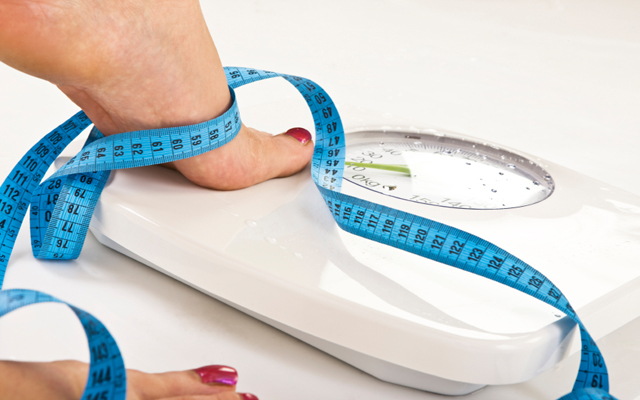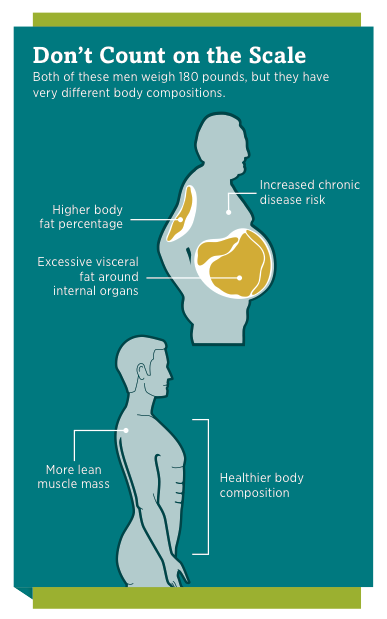It’s time to say something about scales. What exactly does the scale tell you? And what doesn’t it tell you? The truth: it’s really just about weight. It doesn’t tell you what exactly that weight represents in your body.
Scales can’t be trusted as a determinant of health. It’s possible to weigh less, yet still be unhealthy. For this reason, the scale is not what you should be focusing on when trying to improve your health.
For example, a strong, muscular person could weigh the same as someone with a greater percentage of body fat, and yet their health would be drastically different. The same idea applies to someone who has a normal body weight but has a high percentage of body fat—also known as being “skinny fat.”
Crash dieting leads to a slow metabolism
There’s a common rule of thumb about dieting that everyone should know: for every pound of body fat loss, a person generally loses anywhere from an eighth to a quarter pound of fat-free mass—a small chunk—that’s made up of mostly muscle, liver or muscle glycogen (a stored carbohydrate), bone, and water (1, 2). However, certain diets can increase the amount of fat-free mass that is lost. An example of this is with “crash dieting,” when people go on extremely low-calorie diets. In the end, they end up losing a lot of weight, but it’s usually at the expense of a significant amount of muscle and bone (1, 2).
Muscle and bone are principal factors in influencing basal metabolic rate, which means that any loss leads to fewer calories burned daily (3). Supposing that after a crash diet a person returns to old eating habits, the result is going to be rapid weight gain (1). Discouraged by what the scale says, that person might be led to doing yet another crash diet. Unfortunately, due to a messed up metabolism from bone and muscle loss, weight loss becomes harder to achieve.
There’s a way out of this downward spiral of “weight loss cycling“ and it involves getting strong and staying strong during weight loss. The goal is, ultimately, changing body composition. Some may have said in the past that it’s just not possible, but evidence from the scientific literature is suggesting otherwise—that you can burn fat while maintaining and building muscle (5-6).
It’s wrong to say that diet is more important than physical activity, or vice versa. For health and quality weight loss, they are equal sides of a coin. Because while it’s true that (in most cases) diet is by far going to be the greatest factor in the “calories in/calories out” equation, exercise is the greatest contributor to keeping or building stronger muscle and bones. For this reason it’s argued by some that exercise becomes even more important when losing weight.
When it comes to exercise for healthy weight loss, resistance training is best, lifting weights in particular. The “why” is simple: resistance training puts pressure on muscle and bones, stimulating adaptation (3). Muscle and bone adaptation basically means growth and remodeling. If you really want to spur adaptation, try resistance training at a high intensity (bringing heart rate up 80 to 90 percent of your maximum heart rate) (4).
Adaptation is itself an extensive, energy-draining process. In short, you’ll be burning calories. The nutrients from your diet are more likely to serve as building blocks for that growth and recovery rather than storage in the form of fat. Better to have calories working for you (for muscle), not against you (as body fat).
Staying stronger takes protein and nutrition
As important as exercise for adaptation, is nutrition. To put it metaphorically, a house or building just can’t be built (or built well) without the right materials in the right amounts and at the right time. Neither can muscle and bone growth and remodeling occur after resistance training without nutrients, including protein and calcium, or the right fuel in the form of sufficient dietary calories consumed each day.
Generally, the body will lose minor amounts of protein and calcium every day. But that loss can increase with weight loss and when the diet is lacking these nutrients. The dietary goal for a person losing weight should be to provide correct dosages of nutrients at the right time to optimize preservation of lean mass.
Steady weight loss (as opposed to what happens on a crash diet) combined with resistance training and regular intake of protein, calcium, vitamin D, B vitamins, and other nutrients help to preserve lean mass (5-9). So can sufficient calories per day for an average woman or man.
For lean mass preservation, the quality of nutrients matters, too, as is the case of protein. Depending on its source, the quality of dietary protein can vary. For example, whey protein is shown in studies to outrank other sources of protein for muscle growth because it’s rich in branched-chain amino acids (BCAAs) that stimulate protein synthesis. Whey protein is also absorbed more quickly and it’s more easily incorporated into tissues (10-13).
Building muscle and bone may seem counterintuitive for someone who simply wants to see a difference on the scale. After all, muscle and bone weigh more than fat. But muscle and bone have a greater density in comparison to body fat, so lend less to size.
Don’t focus solely on losing weight. A healthy, toned body can be achieved through a true body composition transformation. It’s there where Isagenix products can make a difference.
References
- Heymsfield SB, et al. Weight loss composition is one-fourth fat-free mass: a critical review and critique of this widely cited rule. Obesity Reviews. 2014;15(4)310-31
- Hughes VA, et al. Longitudinal changes in body composition in older men and women: role of body weight change and physical activity. Am J Clin Nutr. 2002;76:473-81.
- Wolfe R. The underappreciated role of muscle in health. Muscle in Health and Disease. Am J Clin Nutr. 2006;84:475–82.
- Gibala MJ1, Jones AM. Physiological and performance adaptations to high-intensity interval training. Nestle Nutr Inst Workshop Ser. 2013;76:51-60.
- Westerterp-Plantenga MS, et al. Dietary protein – its role in satiety, energetics, weight loss and health. Br J Nutr. 2012 Aug;108 Suppl 2:S105-12.
- Soenen S, et al. Normal Protein Intake Is Required for Body Weight Loss and Weight Maintenance, and Elevated Protein Intake for Additional Preservation of Resting Energy Expenditure and Fat Free Mass. J Nutr, 2013.
- Acheson KJ. Diets for body weight control and health: the potential of changing the macronutrient composition. Eur J Clin Nutr, 2012
- Jesudason D, et al. Comparison of 2 weight-loss diets of different protein content on bone health: a randomized trial. Am J Clin Nutr. 2013 Nov;98(5):1343-52.
- Jesudason D, et al. B-vitamins and bone in health and disease: the current evidence. Proc Nutr Soc. 2014 Feb 26:1-10. [Epub ahead of print]
- Phillips SM et al. The role of milk- and soy-based protein in support of muscle protein synthesis and muscle protein accretion in young and elderly persons. J Am Coll Nutr. 2009;28(4):343-54.
- Hulmi JJ et al. Effect of protein/essential amino acids and resistance training on skeletal muscle hypertrophy: A case for whey protein. Nutr Metab (Lond). 2010 Jun 17;7:51.
- Pennings B et al. Amino acid absorption and subsequent muscle protein accretion following graded intakes of whey protein in elderly men. Am J Physiol Endocrinol Metab. 2012;302:E992-E999.
- Pennings B et al. Whey protein stimulates postprandial muscle protein accretion more effectively than do casein and casein hydrolysate in older men. Am J Clin Nutr, 2011;93: 997-1005.






